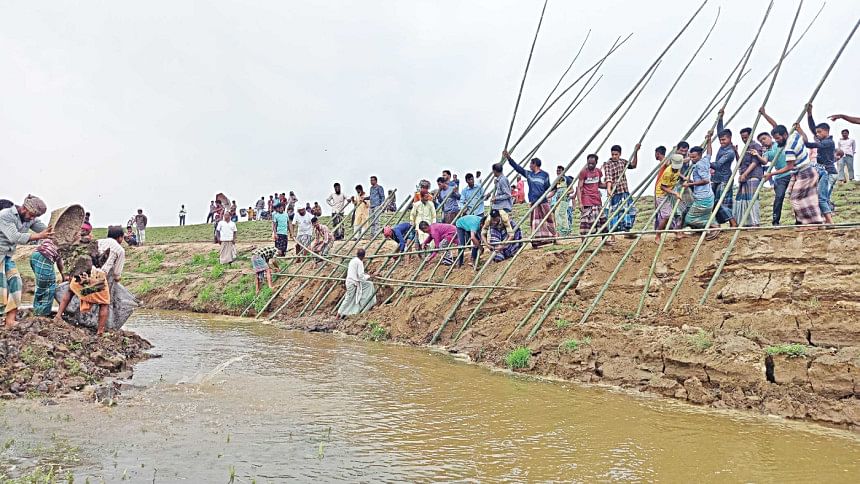Haor recoils in horror

Farmers in the northern region of the country are fearing huge financial loss in this Boro season because of flash floods.
Around 7,083 hectares of croplands with Boro harvest, including 4,900 hectares in Sunamganj alone, were submerged till yesterday in the region.
Farmers in Sunamganj, Sylhet, Netrakona and Kishoreganj are the worst affected by the first blow of flash flood originating for the torrential rain in India's Meghalaya.
The Department of Agriculture Extension (DAE) officials could not confirm the estimated financial loss.
However, according to the statistical data of production, 6.5 tonnes per hectare on average, the loss is estimated at around Tk 125 crore.
Meanwhile, the Flood Forecasting and Warning Centre (FFWC) of the Bangladesh Water Development Board (BWDB) forecasted another flash flood by the end of the week.
Farmers in the haor areas are suffering the most because of the flash flood.
Farmer Aynal Miah, 60, of Joypur village in Sunamganj's Tahirpur upazila, said he cultivated Boro on two acres of land in the Tanguar Haor.
The flash flood that hit the district on April 1, submerged and destroyed his hard-laboured yield.
"We tried hard to protect the dyke but we could not. This was my total produce for this year," the elderly farmer said.
Like Aynal, hundreds of farmers of the haor areas cultivated Boro on 4.03 lakh hectares of land and they were eyeing good produce for favourable weather.
After the first blow incurred nominal loss considering the cultivated lands, farmers became hopeful as the rain stopped upstream and water started receding.
The FFWC forecast, however, hit them hard and now most of the farmers are passing their time on the dykes to protect their yield.
According to the FFWC bulletin yesterday, it will rain heavily in the north-eastern districts and in India's Meghalaya and Assam provinces in the next 24 to 72 hours.
FFWC Executive Engineer Arifuzzaman Bhuiyan said, "Considering the rainfall, we are forecasting another flash flood by the end of this week.
"Given the water level in the rivers, moderate rainfall will cause huge damage in Sunamganj, Netrakona and Kishoreganj."
Tara Miah, a farmer in Sunamangaj's Madhyanagar upazila, said, "Only a few days remaining for the paddy to ripen enough for cutting. If another flood hits, I will lose everything as the nearby levee is in a poor state and cannot take another blow."
To protect the harvest, 520 kilometres of levees were constructed and repaired in Sunamganj district alone spending Tk 120 crore.
However, two large levees -- one at Chandra Shonar Thal in Dharmapasha upazila and another at Chaptir Haor in Derai upazila -- broke and thousands of hectares were inundated.
According to the BWDB, all levees are now at risk as they suffered the first blow and may not sustain another.
Mohammad Shamsuddoha, executive engineer of Sunamganj BWDB, said, "We are focusing on protecting the standing levees and mobilising sandbags and other materials to the volunteering farmers to protect all damaged levees."
After the 2017 flash flood that devastated the haor region, the government revised the "Kajer Binimoye Taka Rules -2017" and Project Implementation Committees (PIC) formed by the farmers are given authority to construct levees.
According to the policy, all PICs must be formed by November 30 of a year, the repair work is to start by December 15 and to be completed by February 28.
Kashmir Reza, president of Haor O Paribesh Unnnayan Sangtha, said, "The levees are weaker than it should be because they delayed starting the work and hurried to finish them. As the compaction was not properly done, these levees are not holding up the floodwater."
Meanwhile, Planning Minister and Sunamganj-3 Parliamentarian MA Mannan yesterday visited haor and levees in Shantiganj and Jagannathpur upazilas.
During his visit, he spoke with the farmers who complained of corruption, negligence and anomalies centring the levee construction projects.
"No one shall be spared if negligence and corruption are found after investigating the matter. But our priority now is to sustain the remaining levees from another flash flood," the minister said.
All concerned authorities should be watchful and the damaged farmers will be compensated."

 For all latest news, follow The Daily Star's Google News channel.
For all latest news, follow The Daily Star's Google News channel. 



Comments